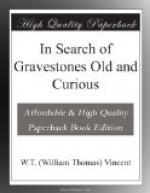“Who
would lay
His body in the City burial-place,
To be cast up again by some rude sexton?”
In my experience the chief sinner is not the city, but the country, sexton.
Other memorials than the headstone are scarcely included in my subject. Few of the slate slabs which answer the purpose in Wales and some of the bordering counties can maintain their inscriptions in legible condition for a very long period, and they are in all respects inferior to stone in durability. This thought would have given no anxiety to the writer of some Chapters on Churchyards which appeared in “Blackwood’s Magazine” about 1820. Said he:
“In parts of Warwickshire and some of the adjacent counties, more especially in the churchyards of the larger towns, the frightful fashion of black tombstones is almost universal—black tombstones, tall and slim, and lettered in gold, looking for all the world like upright coffin-lids.... Some village burial-grounds here have, however, escaped this treatment, and within the circuit of a few miles round Warwick itself are many small hamlet churches each surrounded by its lowly flock of green graves and grey headstones.... some half sunk into the churchyard mould, many carved out into cherubins with their trumpeter’s cheeks and expanded wings, or with the awful emblems, death’s heads and bones and hour-glasses.”
Of the so-called black tombstones I have seen none other than slate.
In a short tour through Wales, in 1898, I found very few old headstones. Most of the memorials in the churchyards were constructed of slate, which abundant material is devoted to every conceivable purpose. There is a kind of clay-slate more durable than some of the native stones, and even the poorer slate which perisheth is lasting in comparison with the wooden planks which have been more or less adopted in many burial-places, but can never have been expected to endure more than a few brief years. Wherever seen they are usually in decay, and under circumstances so forlorn that it is an act of mercy to end their existence.




